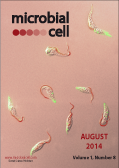Table of contents
Volume 1, Issue 8, pp. 256 - 275, August 2014
Cover: Trypanosomes with motile flagella (red) that are nucleated by the flagellar basal bodies (green) and are attached to the cell body. Nuclei and kinetoplasts, the cell’s unique mitochondrial DNA complex, are shown in blue. Image was acquired using epifluorescence microscopy by Ziyin Li (University of Texas Medical School at Houston, USA). The cover is published under the Creative Commons Attribution (CC BY) license.
Enlarge issue cover
Multiple metabolic requirements for size homeostasis and initiation of division in Saccharomyces cerevisiae
Shivatheja Soma, Kailu Yang, Maria I. Morales, Michael Polymenis
Research Articles |
page 256-266 | 10.15698/mic2014.08.160 | Full text | PDF |
Abstract
Most cells must grow before they can divide, but it is not known how cells determine when they have grown enough so they can commit to a new round of cell division. Several parameters affect the timing of initiation of division: cell size at birth, the size cells have to reach when they commit to division, and how fast they reach that size. We report that Saccharomyces cerevisiae mutants in metabolic and biosynthetic pathways differ in these variables, controlling the timing of initiation of cell division in various ways. Some mutants affect the size at birth, size at initiation of division, the rate of increase in size, or any combination of the above. Furthermore, we show that adenylate kinase, encoded by ADK1, is a significant determinant of the efficiency of size control mechanisms. Finally, our data argue strongly that the cell size at division is not necessarily a function of the rate cells increase in size in the G1 phase of the cell cycle. Taken together, these findings reveal an unexpected diversity in the G1 cell cycle phenotypes of metabolic and biosynthetic mutants, suggesting that growth requirements for cell division are multiple, distinct and imposed throughout the G1 phase of the cell cycle.
A novel role of centrin in flagellar motility: stabilizing an inner-arm dynein motor in the flagellar axoneme
Ziyin Li
Microreviews |
page 267-269 | 10.15698/mic2014.08.161 | Full text | PDF |
Abstract
Centrin is an evolutionarily conserved EF-hand calcium-binding protein found in the centriole of animals and the basal body of flagellated organisms. It was originally discovered in the flagellated unicellular green alga Chlamydomonas reinhardtii, where it associates with flagellum-associated structures and regulates basal body duplication and flagellar motility. Centrin constitutes a light chain of three inner-arm dynein complexes in the flagellar axoneme in Chlamydomonas, and presumably regulates the activity of the inner-arm dynein for flagellar motility. In the ciliated organism Tetrahymena, centrin also associates with the inner-arm dynein and appears to regulate the microtubule sliding velocity of the inner-arm dynein. Using Trypanosoma brucei as the model organism, we discovered that centrin maintains the stability of an inner-arm dynein in the flagellar axoneme [Wei et al., (2014) Nat. Commun 5: 4060]. T. brucei expresses five centrins, three of which, TbCentrin1, 2, and 4, associate with the flagellar basal body, but no centrin was found to regulate cell motility. We found that TbCentrin3 associates tightly with the flagellum and that RNAi of TbCentrin3 compromised cell motility. Biochemical approaches further showed that TbCentrin3 interacts with TbIAD5-1, an inner-arm dynein in the flagellar axoneme. Knockdown of TbIAD5-1 also caused defective cell motility. Strikingly, depletion of TbCentrin3 or depletion of TbIAD5-1 resulted in disassembly of the complex from the axoneme and subsequent degradation of the complex in the cytosol. Our findings identified a novel role of TbCentrin3 in cell motility by stabilizing TbIAD5-1 in the axoneme, which likely is well conserved in other flagellated and ciliated organisms, such as Chlamydomonas and Tetrahymena where centrin is also known to associate with inner-arm dyneins.
Increased Trypanosoma brucei cathepsin-L activity inhibits human serum-mediated trypanolysis
Sam Alsford
Microreviews |
page 270-272 | 10.15698/mic2014.08.162 | Full text | PDF |
Abstract
Most African trypanosomes, including the veterinary species Trypanosoma brucei brucei and T. congolense are susceptible to lysis by human serum. A recent study by Alsford et al. [PLoS Pathogens (2014) 10, e1004130] has identified a T. b. brucei lysosomal cathepsin with an inhibitory effect on human serum’s trypanolytic action.
The replication timing program in the hands of two HDACs
Kazumasa Yoshida, Armelle Lengronne, Philippe Pasero
Microreviews |
page 273-275 | 10.15698/mic2014.08.163 | Full text | PDF |
Abstract
In eukaryotes, duplication of genomic information depends on the sequential activation of multiple replication origins distributed along the chromosomes. Replication origins differ in initiation time, chromatin structure and three-dimensional position in the nucleus. Recently, we have performed a systematic analysis of the role of histone deacetylases (HDACs) in the regulation of origin activity in budding yeast. We have found that the epigenetic regulation of repetitive sequences is a key determinant of the DNA replication program. Indeed, our study revealed that two histone deacetylases, Rpd3 and Sir2, have opposite effects on the replication timing program. Rpd3 delays initiation at late origins, whereas Sir2 promotes efficient activation of early origins. Remarkably, we also found that Rpd3 and Sir2 regulate initiation at ~200 replication origins located within the ribosomal DNA (rDNA) array. We propose that this epigenetic regulation of repetitive origins controls the replication timing program by modulating the availability of limiting initiation factors.










